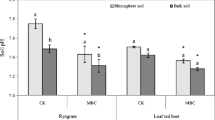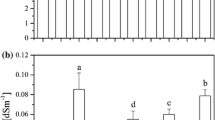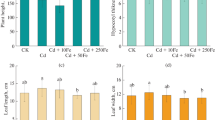Abstract
Previous researches have confirmed that modified nanoscale carbon black (MCB) can decrease the bioavailability of heavy metals in soil and accumulation in plant tissues, resulting in the increase of biomass of plant. However, as a nanoparticle, the effects of MCB on plant cell morphology and microbial communities in Cd-contaminated soil are poorly understood. This study, through greenhouse experiments, investigated the effects of MCB as an amendment for 5 mg·kg-1 Cd-contaminated soil on plant growth, plant cellular morphogenesis, and microbial communities. Two types of plants, metal-tolerant plant ryegrass (Lolium multiflorum), and hyperaccumulator plant chard (Beta vulgaris L. var. cicla) were selected. The results indicated that adding MCB to Cd-contaminated soil, the dry biomass of shoot ryegrass and chard increased by 1.07 and 1.05 times, respectively, comparing with control group (the treatment without MCB). Meanwhile, the physiological characteristics of plant root denoted that adding MCB reduced the damage caused by Cd to plants. The acid phosphatase activity of soils treated with MBC was higher and the dehydrogenase activity was lower than control group during whole 50 days of incubation, while the urease and catalase activity of soils treated with MBC were higher than control group after 25 days of incubation. When compared with the treatment without MCB, the abundances of nitrogen-functional bacteria (Rhodospirillum and Nitrospira) and phosphorus-functional bacteria (Bradyrhizobium and Flavobacterium) increased but that of nitrogen-functional bacteria, Nitrososphaera, declined. The presence of MCB resulted in increased microbial community abundance by reducing the bioavailability of heavy metals in soil, while increasing the abundance of plants by increasing the amount of available nitrogen in soil. The result of this study suggests that MCB could be applied to the in-situ immobilization of heavy metal in contaminated soils because of its beneficial effects on plants growth, root cellular morphogenesis, and microbial community.







Similar content being viewed by others
References
Angelvicova L, Lodenius M, Tulisalo E, Fazekasova D (2014) Effect of heavy metals on soil enzyme activity at different field conditions in middle Spis mining area (Slovakia). Bull Environ Contam Toxicol 93:670–675. https://doi.org/10.1007/s00128-014-1397-0
Bouzon ZL, Ferreira EC, Santos R, Scherner F, Horta PA, Maraschin M, Schmidt EC (2012) Influences of cadmium on fine structure and metabolism of Hypnea musciformis (Rhodophyta, Gigartinales) cultivated in vitro. Protoplasma 249:637–650. https://doi.org/10.1007/s00709-011-0301-6
Cao X (2018) Immobilization of heavy metals in contaminated soils amended by phosphate-, carbonate-, and silicate-based materials: from lab to field. In: Luo Y, Tu C (eds) Twenty years of research and development on soil pollution and remediation in China, pp 535–543. https://doi.org/10.1007/978-981-10-6029-8_32
Chai H, Yao J, Sun J, Chang C, Liu W, Zhu M, Ceccanti B (2015) The effect of metal oxide nanoparticles on functional bacteria and metabolic profiles in agricultural soil. Bull Environ Contam Toxicol 94:490–495. https://doi.org/10.1007/s00128-015-1485-9
Cheng J, Liu Y, Wang H (2014) Effects of surface-modified Nano-scale carbon black on Cu and Zn fractionations in contaminated soil. Int J Phytoremediation 16:86–94. https://doi.org/10.1080/15226514.2012.759530
Cheng J, Yu L, Li T, Liu Y, Lu C, Li TT, Wang H (2015) Effects of nano-scale carbon black modified by HNO3 on immobilization and phytoavailability of Ni in contaminated soil. J Chem 2:1–7. https://doi.org/10.1155/2015/839069
Cheng J, Sun Z, Yu Y, Li X, Li T (2019) Effects of modified carbon black nanoparticles on plant-microbe remediation of petroleum and heavy metal co-contaminated soils. Int J Phytoremediation 21(7):634–642. https://doi.org/10.1080/15226514.2018.1556581
Chu Z, Wang X, Wang Y, Liu G, Dong Z, Lu X, Chen G, Zha F (2018) Effects of coal spoil amendment on heavy metal accumulation and physiological aspects of ryegarss (Lolium perenne L.) growing in copper mine tailings. Environ Monit Assess 190:1–12. https://doi.org/10.1007/s10661-017-6400-x
Corredor E, Testillano PS, Coronado MJ, González-Melendi P, Fernández-Pacheco R, Marquina C, Ibarra MR, Fuente JMDL, Rubiales D, Pérez-De-Luque A (2009) Nanoparticle penetration and transport in living pumpkin plants: in situ subcellular identification. BMC Plant Biol 9:45–55. https://doi.org/10.1186/1471-2229-9-45
Costa GB, Simioni C, Pereira DT, Ramlov F, Maraschin M, Chow F, Horta PA, Bouzon ZL, Schmidt EC (2017) The brown seaweed Sargassum cymosum: changes in metabolism and cellular organization after long-term exposure to cadmium. Protoplasma 254(2):817–831. https://doi.org/10.1007/s00709-016-0992-9
Daims H, Lebedeva EV, Pjevac P, Han P, Herbold C, Albertsen M, Jehmlich N, Palatinszky M, Vierheilig J, Bulaev A, Kirkegaard RH, Bergen MV, Rattei T, Bendinger B, Nielsen PH, Wagner M (2015) Complete nitrification by Nitrospira bacteria. Nature 528:504–509. https://doi.org/10.1038/nature16461
Deng L, Zeng G, Fan C, Lu L, Chen X, Chen M, Wu H, He X, He Y (2015) Response of rhizosphere microbial community structure and diversity to heavy metal co-pollution in arable soil. Appl Microbiol Biotechnol 99:8259–8269. https://doi.org/10.1007/s00253-015-6662-6
Ge Y, Priester JH, Mortimer M, Chang CH, Ji Z, Schimel JP, Holden PA (2016) Long-term effects of multiwalled carbon nanotubes and graphene on microbial communities in dry soil. Environ Sci Technol 50(7):3965–3974. https://doi.org/10.1021/acs.est.5b05602
Gucwa-Przepiora E, Nadgorska-Socha A, Fojcik B, Chmura D (2016) Enzymatic activities and arbuscular mycorrhizal colonization of Plantago lanceolata and Plantago major in a soil root zone under heavy metal stress. Environ Sci Pollut Res 23:4742–4755. https://doi.org/10.1007/s11356-015-5695-9
Hao Y, Cao X, Ma C, Zhang Z, Zhao N, Ali A, Hou T, Xiang Z, Zhuang J, Wu S, Xing B, Zhang Z, Rui Y (2017) Potential applications and antifungal activities of engineered nanomaterials against gray mold disease agent Botrytis cinerea on rose petals. Front Plant Sci 8:1332. https://doi.org/10.3389/fpls.2017.01332
Hao Y, Ma C, Zhang Z, Song Y, Cao W, Guo J, Zhou G, Rui Y, Liu L, Xing B (2018) Carbon nanomaterials alter plant physiology and soil bacterial community composition in a rice-soil-bacterial ecosystem. Environ Pollut 232:123–136. https://doi.org/10.1016/j.envpol.2017.09.024
Hartwig A (2013) Cadmium and Cancer. In: Sigel A, Sigel H, Sigel R (eds) Cadmium: from toxicity to essentiality. Met Ions Life Sci 11:491–507. https://doi.org/10.1007/978-94-007-5179-8-15
Hu XF, Jiang Y, Sun Y, Hu X, Liu L, Luo F (2014) Effects of mining wastewater discharges on heavy metal pollution and soil enzyme activity of the paddy fields. J Geochem Explor 147:130–150. https://doi.org/10.1016/j.gexplo.2014.08.001
Hu Y, Wang D, Li Y (2016) Environmental behaviors and potential ecological risks of heavy metals (Cd, Cr, Cu Pb and Zn) in multimedia in an oilfield in China. Environ Sci Pollut Res 23:13964–13972. https://doi.org/10.1007/s11356-016-6589-1
Jeon H, Carl G, Simon J, Kim G (2015) A mini-review: cell response to microscale, nanoscale, and hierarchical patterning of surface structure. J Biomed Mater Res B Appl Biomater 102:1580–1594. https://doi.org/10.1002/jbm.b.33158
Ji Y, Zhou Y, Ma C, Feng Y, Hao Y, Rui Y, Wu W, Gui X, Le VN, Han Y, Wang Y, Xing B, Liu L, Cao W (2017) Jointed toxicity of TiO2 NPs and Cd to rice seedlings: NPs alleviated Cd toxicity and Cd promoted NPs uptake. Plant Physiol Biochem 110:82–93. https://doi.org/10.1016/j.plaphy.2016.05.010
Jin L, Son Y, Yoon TK, Kang YJ, Kim W, Chung H (2013) High concentrations of single-walled carbon nanotubes lower soil enzyme activity and microbial biomass. Ecotoxicol Environ Saf 88:9–15. https://doi.org/10.1016/j.ecoenv.2012.10.031
Khan S, El-Latif Hesham A, Qiao M, Rehman S, He J (2010) Effects of Cd and Pb on soil microbial community structure and activities. Environ Sci Pollut Res 17:288–296. https://doi.org/10.1007/s11356-009-0134-4
Konate A, He X, Zhang Z, MaY ZP, Alugongo GM, Rui Y (2017) Magnetic (Fe3O4) nanoparticles reduce heavy metals uptake and mitigate their toxicity in wheat seedling. Sustainability 9(5):790. https://doi.org/10.3390/su9050790
Kumar SV, Kumar AD, Kumar MP, Shah A, Kumar V, Gantait S (2018) Engineered nanomaterials for plant growth and development: a perspective analysis. Sci Total Environ 630:1413–1435. https://doi.org/10.1016/j.scitotenv.2018.02.313
Kumar A, Gupta K, Dixit S, Mishra K, Srivastava S (2019a) A review on positive and negative impacts of nanotechnology in agriculture. Int J Environ Sci Technol 16:2175–2184. https://doi.org/10.1007/s13762-018-2119-7
Kumar SV, Kumar AD, Gantait S, Kumar V, Gurel E (2019b) Applications of carbon nanomaterials in the plant system: a perspective view on the pros and cons. Sci Total Environ 667:485–499. https://doi.org/10.1016/j.scitotenv.2019.02.409
Lejon DPH, Pascault N, Ranjard L (2010) Differential copper impact on density, diversity and resistance of adapted culturable bacterial populations according to soil organic status. Eur J Soil Biol 46:168–174. https://doi.org/10.1016/j.ejsobi.2009.12.002
Li J, Xu Y, Ling X, Lin D, Sun Y, Wang L (2014) In situ immobilization remediation of heavy metals in contaminated soils: a review. Ecol Environ Sci 23(4):721–728. https://doi.org/10.16258/j.cnki.1674-5906.2014.04.013
Liang Y, He X, Liang S, Zhang W, Chen X, Feng S, Su Y (2014) Community structure analysis of soil ammonia oxidizers during vegetation restoration in southwest China. J Basic Microbiol 54(3):180–189. https://doi.org/10.1002/jobm.201300217
Liu Z, Qian G, Zhou J, Li C, Xu Y, Qin Z (2008) Improvement of ground granulated blast furnace slag on stabilization/solidification of simulated mercury-doped wastes in chemically bonded phosphate ceramics. J Hazard Mater 157(1):146–153. https://doi.org/10.1016/j.jhazmat.2007.12.110
Lyv Y, Yu Y, Li T, Cheng J (2018) Rhizosphere effects of Loliumperenne L. and Betavulgaris var. cicla L. on the immobilization of Cd by modified nanoscale black carbon in contaminated soil. J Soils Sediments 18(1):1–11. https://doi.org/10.1007/s11368-017-1724-2
Ma JF, Ueno D, Zhao FJ, McGrath SP (2005) Subcellular localisation of Cd and Zn in the leaves of a Cd-hyperaccumulating ecotype of Thlaspi caerulescens. Planta 220(5):731–736. https://doi.org/10.1007/s00425-004-1392-5
Madigan M, Cox SS, Stegeman RA (1984) Nitrogen fixation and nitrogenase about activities in members of the family Rhodospirilla. J Bacteriol 157(1):73–81
Minnikova TV, Denisova TV, Mandzhieva SS, Kolesnikov SI, Minkian TM, Chaplygin VA, Burachevskaya MV, Sushkova SN, Bauer TV (2017) Assessing the effect of heavy metals from the Novocherkassk power station emissions on the biological activity of soils in the adjacent areas. J Geochem Explor 174:70–78. https://doi.org/10.1016/gexplo.2016.06.007
Mohamed BA, Ellis N, Kim CS, Bi X (2017) The role of tailored biochar in increasing plant growth, and reducing bioavailability, phytotoxicity, and uptake of heavy metals in contaminated soil. Environ Pollut 230:320–338. https://doi.org/10.1016/j.envpol.2017.06.075
Mohtadi A, Ghaderian SM, Schat H (2012) A comparison of lead accumulation and tolerance among heavy metal hyperaccumulating and non-hyperaccumulating metallophytes. Plant Soil 352:267–276. https://doi.org/10.1007/s11104-011-0994-5
Qin Y, Li X, Xu W, Chai Y, Chi S, Wang W, Li T, Huang C, Zheng Y (2018) Effects of exogenous cadmium on activity of antioxidant enzyme, Cd uptake and chemical forms of ryegrass. Appl Ecol Environ Res 16(2):1019–1035. https://doi.org/10.15666/aeer/1602_10191035
Rizwan M, Ali S, Qayyum MF, Ok YS, Adrees M, Ibrahim M, Zia-ur-Rehman M, Farid M, Abbas F (2017) Effect of metal and metal oxide nanoparticles on growth and physiology of globally important food crops: a critical review. J Hazard Mater 322:2–16. https://doi.org/10.1016/j.jhazmat.2016.05.061
Rodrigo WDS, Schmidt ÉC, Bouzon ZL (2013) Changes in ultrastructure and cytochemistry of the agarophyte Gracilaria domingensis (Rhodophyta, Gracilariales) treated with cadmium. Protoplasma 250(1):297–305. https://doi.org/10.1007/s00709-012-0412-8
Rodriguez MJA, Arana DC, Ramos-Miras JJ, Gil C, Boluda R (2015) Impact of 70 years urban growth associated with heavy metal pollution. Environ Pollut 196:156–163. https://doi.org/10.1016/j.envpol.2014.10.014
Ruttens A, Adriaensen K, Meers E, De Vocht A, Geebelen W, Carleer R, Mench M, Vangronsveld J (2010) Long-term sustainability of metal immobilization by soil amendments: cyclonic ashes versus lime addition. Environ Pollut 158:1428–1434. https://doi.org/10.1016/j.envpol.2009.12.037
Servin A, Elmer W, Mukherjee A, Torre-Roch R, Handi H, White JC, Bindarban P, Dimkpa C (2015) A review of the use of engineered nanomaterials to suppress plant disease and enhance crop yield. J Nanopart Res 17:92. https://doi.org/10.1007/s11051-015-2907-7
Singh A, Prasad SM (2015) Remediation of heavy metal contaminated ecosystem: an overview on technology advancement. Int J Environ Sci Technol 12:353–366. https://doi.org/10.1007/s13762-014-0542-y
Sun Y, Sun G, Xu Y, Liu W, Liang X, Wang L (2016) Evaluation of the effectiveness of sepiolite, bentonite, and phosphate amendments on the stabilization remediation of cadmium-contaminated soils. J Environ Manag 166:204–210. https://doi.org/10.1016/j.jenvman.2015.10.017
Wang Z, Xie X, Zhao J, Liu X, Feng W, White JC, Xing B (2012) Xylem- and phloem-based transport of CuO nanoparticles in maize (Zea mays L.). Environ Sci Technol 46:4434–4441. https://doi.org/10.1021/es204212z
Yang Z, Liu S, Zhang D, Feng S (2006) Effects of cadium, zinc and lead on soil enzyme activities. J Environ Sci 18(6):1135–1147. https://doi.org/10.1016/S1001-0742(06)60051-X
Yang Q, Li Z, Lu X, Duan Q, Huang L, Bi J (2018) A review of soil heavy metal pollution from industrial and agricultural regions in China: pollution and risk assessment. Sci Total Environ 642:690–700. https://doi.org/10.1016/j.scitotenv.2018.06.068
Zhao Q, Luo Y (2015) The macro strategy of soil protection in China. Bull Chin Acad Sci 30(4):452–458. https://doi.org/10.16418/j.issn.1000-3045.2015.04.003
Zhao Q, Huang G, Qan H (2007) Ecological agriculture and food safety. Acta Pedol Sin 44(6):1127–1134. https://doi.org/10.11766/trxb200606200624
Zhou D, Wang Y, Wang H, Wang S, Cheng J (2010) Surface-modified nanoscale carbon black used as sorbents for Cu(II) and Cd(II), J Hazard Mater 174:34–39. https://doi.org/10.1016/j.jhazmat.2009.09.012
Funding
This work was supported by the National Natural Science Fund Committee, China (Grant Numbers. 41877119 and 41471255) and the National Key Research and Development Program of China (Grant Numbers. 2018YFD0800306-04 and 2018YFF0213404).
Author information
Authors and Affiliations
Corresponding author
Additional information
Responsible editor: Kitae Baek
Publisher’s note
Springer Nature remains neutral with regard to jurisdictional claims in published maps and institutional affiliations.
Electronic supplementary material
ESM 1
(DOCX 92 kb)
Rights and permissions
About this article
Cite this article
Cheng, J., Sun, Z., Li, X. et al. Effects of modified nanoscale carbon black on plant growth, root cellular morphogenesis, and microbial community in cadmium-contaminated soil. Environ Sci Pollut Res 27, 18423–18433 (2020). https://doi.org/10.1007/s11356-020-08081-z
Received:
Accepted:
Published:
Issue Date:
DOI: https://doi.org/10.1007/s11356-020-08081-z




